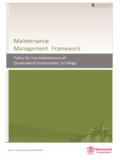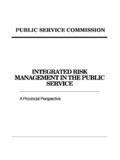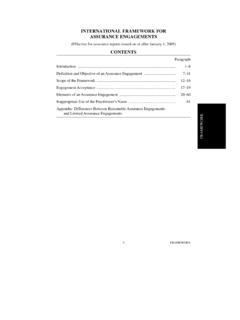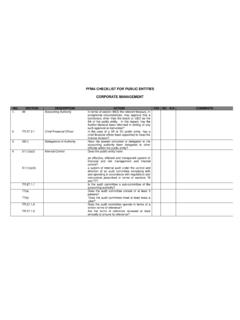Transcription of Internal Control—Integrated Framework - AECHILE
1 Committee of Sponsoring Organizations of the Treadway CommissionSeptember 2012 Illustrative Tools for assessing Effectiveness of a System of Internal ControlInternal Control Integrated FrameworkCommittee of Sponsoring Organizations of the Treadway CommissionExposure Period VersionExposure Period Version 2012 All Rights Reserved. No part of this publication may be reproduced, redistributed, transmitted or displayed in any form or by any means without written permission. For information regarding licensing and reprint permissions please contact the American Institute of Certified Public Accountants, licensing and permissions agent for COSO copyrighted materials. Direct all inquiries to or to AICPA, Attn: Manager, Rights and Permissions, 220 Leigh Farm Rd., Durham, NC 27707. Telephone inquiries may be directed to of Sponsoring Organizations of the Treadway CommissionSeptember 2012 Illustrative Tools for assessing Effectiveness of a System of Internal ControlInternal Control Integrated FrameworkCommittee of Sponsoring Organizations of the Treadway CommissionExposure Period VersionExposure Period VersionCommittee of Sponsoring Organizations of the Treadway Commission Board Members Representative COSO Chair David L.
2 LandsittelAmerican Accounting Association Mark S. Beasley Douglas F. PrawittThe Institute of Internal Auditors Richard F. ChambersAmerican Institute of Certified Public Accountants Charles E. LandesFinancial Executives International Marie N. HolleinInstitute of Management Accountants Sandra Rictermeyer Jeffrey C. Thomson PwCAuthorPrincipal Contributors Miles Everson Engagement Leader New York, USA Stephen E. Soske Project Lead Partner Boston, USA Jay A. Posklensky Project Lead Director Florham Park, USACara M. Beston Partner San Jose, USA Charles E. Harris Partner Florham Park, USA J. Aaron Garcia Director San Diego, USA Subhojit Goswami Director New York, USAK eith Handler Director Florham Park, USAC atherine I. Jourdan Director Paris, France Frank J. Martens Director Vancouver, Canada Sallie Jo Perraglia Manager New York, USAE xposure Period VersionAdvisory CouncilSponsoring Organizations RepresentativesAudrey A.
3 Gramling Bellarmine University Fr. Raymond J. Treece Endowed ChairSteven E. Jameson Community Trust Bank Executive Vice President and Chief Internal Audit & Risk OfficerJ. Stephen McNallyCampbell Soup Company Finance Director/ControllerRay Purcell Pfizer Director of Financial ControlsBill Schneider AT&T Director of AccountingMembers at LargeJennifer BurnsDeloittePartnerJim DeLoach Protiviti Managing DirectorTrent Gazzaway Grant Thornton PartnerCees Klumper The Global Fund to Fight AIDS, Tuberculosis and Malaria Chief Risk OfficerThomas Montminy PwC PartnerAl Paulus E&Y PartnerThomas Ray KPMG PartnerDr. Larry E. RittenbergUniversity of WisconsinEmeritus Professor of Accounting Chair Emeritus COSOKen Vander Wal ISACA PresidentExposure Period VersionAdvisory Council (cont.)Regulatory Observers and Other ObserversJames Dalkin Government Accountability Office Director in the Financial Management and Assurance TeamHarrison E.
4 Greene, Jr. Federal Deposit Insurance Corporation Assistant Chief AccuntantChristian Peo Securities and Exchange Commission Professional Accounting Fellow (Through June 2012)Amy SteeleSecurities and Exchange CommissionAssociate Chief Accountant (Commencing July 2012)Vincent Tophoff International Federation of AccountantsSenior Technical ManagerKeith Wilson Public Company Accounting Oversight Board Deputy Chief AuditorAdditional PwC ContributorsJunya Hakoda Partner (Retired)Tokyo, JapanAlan Martin Partner Frankfurt, GermanyEric M. BloeschManaging DirectorPhiladelphia, USAJ ames M. DownsDirector San Francisco, USA (Through January 2012)Christopher Michaelson Director Minneapolis, USAE xposure Period VersionPrefaceThis project was commissioned by COSO, which is dedicated to providing thought lead-ership through the development of comprehensive frameworks and guidance on Internal control, enterprise risk management, and fraud deterrence designed to improve organ-izational performance and oversight and to reduce the extent of fraud in organizations.
5 COSO is a private sector initiative, jointly sponsored and funded by: American Accounting Association (AAA) American Institute of Certified Public Accountants (AICPA) Financial Executives International (FEI) Institute of Management Accountants (IMA) The Institute of Internal Auditors (IIA)Post Public Exposure VersionTable of ContentsIntroduction ..1 Templates1. Overall Assessment of Internal Control Template ..82. Component Evaluation Template ..93. Principle Evaluation Templates ..214. Summary of Deficiencies Template ..60 Scenarios5. Scenario A: Is a Principle and Component Present and Functioning? ..626. Scenario B: Are the Five Components Present, Functioning and Operating Together in an Integrated Manner? ..847. Scenario C: How Does a Material Weakness in a Control Activity Impact Principles, Components, and Internal control?
6 1058. Scenario D: Are the Principles and Components Present and Functioning in a Division, Operating Unit, or Function? ..1159. Scenario E: How are the Assessments of Multiple Locations Combined?..132 Exposure Period VersionExposure Period VersionIntroductionIntroductionThis publication, Internal Control Integrated Framework : Illustrative Tools for Assess-ing Effectiveness of a System of Internal Control (Illustrative Tools), is intended to assist management of entities using the COSO Internal Control Integrated Framework : Framework and Appendices ( Framework and Appendices) when assessing effective-ness of a system of Internal control based on the requirements set forth in the Frame-work. More specifically, Illustrative Tools can help management assess whether: Each of the five components and relevant principles are present and function-ing; and The five components are operating together in an integrated manner.
7 For complete details, please refer to the Framework and Appendices, especially Chapter 3, Effective Internal Control, when using Illustrative Tools. This publication is organized into sections: Introduction, Templates and Scenarios: The templates can be used to assess the effectiveness of a system of Internal control and to document such assessment. The scenarios illustrate how the templates can be used to support an assess-ment of effectiveness of a system of Internal templates and scenarios focus on evaluating components and relevant principles, not the underlying controls ( , transaction-level control activities) that effect princi-ples. These tools are not designed with the intent to satisfy any regulatory, jurisdictional, or standard-setting requirements for evaluating the severity of Internal control defi-ciencies associated with a particular objective, such as external financial reporting.
8 As noted in the Framework , regulators, standard-setting bodies, and other relevant third parties may establish criteria for evaluating the severity and corresponding classification and reporting of deficiencies relating to external reporting objectives, operations, and compliance templates included here are designed to present only a summary of the assess-ment results. They are not an integral part of the Framework , and they may not address all matters that need to be considered in assessing a system of Internal control for a specified objective. Further, they do not represent a preferred method of conducting and documenting an assessment. Their purpose is limited to illustrating one possible assessment process based on the requirements set forth in the Framework . Accord-ingly, the templates do not illustrate management s selection of controls to effect prin-ciples or the determination of scope, nature, timing, and extent of testing such controls embedded within each component.
9 The facts and circumstances relevant to an assess-ment will vary among different categories of objectives and among different entities and industries; therefore, the practical adoption and use of these tools will also vary. Internal Control Integrated Framework September 201211 2 3 4 Exposure Period VersionFramework | Illustrative Tools for assessing Effectiveness of a System of Internal ControlForm and Use As the Framework applies to any type of entity, including large and small public, private, governmental and not-for-profit, so do the templates presented in this publication. Management planning to use these templates can modify them to reflect the facts ( , specified objectives and sub-objectives, scope of application, organizational structure) and assessment processes for their entity. For example, An entity with a complex organizational structure can modify or supple-ment the templates appropriately, as illustrated in Scenario E: How are The Assessments of Multiple Locations Combined?
10 A smaller entity can simplify the templates to reflect a less complex organiza-tional structure and to acknowledge a less-formal, less-structured system of Internal control; for instance a system that reflects more direct and continuous communications about Internal control among the CEO, senior managers, and other personnel. An entity may use technology to maintain a consolidated summary of defi-ciencies that is referenced by all the templates rather than having summaries included in each template. Organizations may leverage the templates to develop or configure automated solu-tions to support their separate and/or ongoing evaluations and overall assessment process. Automated solutions can provide relevant information through system-gen-erated reports and dashboards, which in turn may be used by various stakeholders such as the board of directors1, management, auditors, owners, and control and compliance management.




